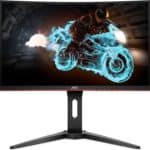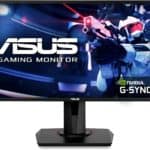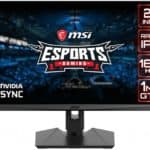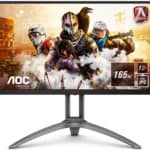The Best Budget 144hz Monitors in 2022
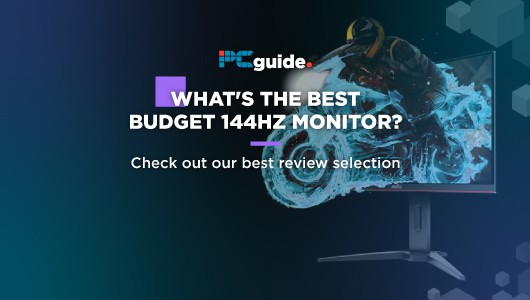
The best budget 144hz monitors are usually aimed at gamers, allowing higher-end gaming PCs and laptops to stretch their legs and display fluid frame rates consistently. It can be a bit of a minefield when trying to pick the best budget 144hz monitor due to a solid feature missing such as response times which affect detail on moving objects in-game, for example.
On the other hand, there are that many features available that are essentially the same product but for different makes of hardware. For example, G-Sync is Nvidia’s answer to reducing screen tearing and frame synchronization, whilst Freesync is AMD’s. In this instance, it’s wise to go with the right feature for your graphics card, which will either be AMD or Nvidia in this day and age.
If your monitor budget isn’t too much of an issue, it might be a good idea to check out our best-curved gaming monitors and best G-Sync monitors.
Products at a Glance
How We Picked The Best Budget 144hz Monitors
We wanted to give a good variety of options, some of which are sub $200 144hz monitors with others under $500 that are great performers for the price. There’s surely a monitor here for every gamer aiming for a bargain based on what features they’re getting. We also wanted to cater to AMD and Nvidia GPU setups whilst giving a bit of scope with screen size and resolution.
The Best Budget 144hz Monitors in 2022
- 165Hz Curved screen for under $150
- 1ms response time
- 165Hz only supported via DP Port
Whilst refresh rates over 144Hz need to be supported by a DP (Display Port) input, this can be combated on most graphics cards without one. For example, most gaming laptops can output via USB 3.0 which can go into DP with the help of an adaptor. With that being said, DP 1.2 and HDMI 2.0 both support 4K up to 60 frames per second, so none of the usual HDMI vs DP comparisons holds much water here.
For this price point, users will be expecting a full HD display (1920 x 1080) and not QHD (also known as 1440p). Considering the monitor is on the smaller end of the scale (24”) and the fast refresh rates and response times, this shouldn’t impact image quality. If you are looking for QHD or UHD/4K resolutions, it might be an idea to save for a while. Overall, this is currently the best bang you’ll get for your buck that also caters for AMD’s Freesync tech.
- G-Sync Compatibility for under $200
- 0.5 ms response time
- On the pricey side considering HDMI 1.2
G-Sync monitors seem to be naturally pricier in today’s market, but a sub $200 165Hz 24” Full HD display is not to be sniffed at. Its 0.5ms response time will ensure no detail is lost during intense and fast-moving sequences overall, and its ultra-low blue light feature will ensure minimum eye strain in dark environments.
It also features a couple of ASUS-branded features that look after control and color balance which is always nice to see in budget monitors. It’s also surprisingly rare to find a budget monitor aimed at gamers that has an adjustable stand with tilt and pivot functionality. Thanks to the DP and Vesa mount compatibility, it’s quite easy to run multiple VG248QG at once with the help of some splitters and decent VESA arms.
- 27” HDR Ready QHD Panel
- Rapid IPS Tech
- Most onboard settings are too sharp
MSI has knocked it out of the park with this reasonably priced monitor. Granted, the settings and presets take some patience to get right, but the results are amazing when set correctly. Bigger screens really do benefit from higher resolutions, MAG274QRF-QD pops when cranking out 1440p alongside quantum dot technology. Colors look realistic, and so they should, MSI boast that there’s over one billion, we’re going to just trust them on that one.
The OSD App is also a cool feature, rather than fiddling with buttons underneath the monitor, MSI allows users to load presets for different pieces of software. This kind of automation alongside programmable display hotkeys is a dream for variety gamers and avid software switchers. Another nice feature is one of the most versatile stands we’ve seen in a budget monitor. It tilts, swivels, pivots, and is height-adjustable, something that comes in really handy for users looking to use MAG274QRF-QD for various tasks.
- Up to 240HZ
- Small screen bezels ideal for multiple display setups
- Pricey for a 1080p screen
AOC are holding their own in the high-performance monitor market in general, but are excelling in the budget sector. At first glance, this monitor may seem a little steep at around $400 for a 1080p screen, but its feature set more than makes up for its lack of 1440p. 240Hz is aiming for high-end GPUs, and it’s something users should be aiming for to take full advantage of what we assume is a massive investment given today’s graphics card market.
0.5ms means more detailed fast-paced action, even more so when it comes to FPS and action titles. Even sports fans will notice the difference here, allowing users to catch every pass with their eyes. It sports a 170-degree viewing angle also, which comes in very handy when taking advantage of those thin bezels and a synced multi-monitor array.
- A great Freesync alternative to MSI
- Fantastic screen quality with simple yet effective settings
- Hard to find in some territories
AGON is the new gaming brand from AOC, and it’s packing a bunch at the border of budget monitor offerings with the incredibly built AG273QXP. The screen pops at a classy 27” @ 1440p, almost letting users forget that 4K UHD exists. The 165Hz refresh rate and 1ms response time compliments this and positions this monitor as a serious contender for the MSI throne in this buyer’s guide.
It’s let down by its limited distribution and basic features, but don’t let these basic features fool you. Sometimes it’s much better to have finely tuned customization with fewer options than an array of options, half of which are about as useful as an Activision executive. It’s also a great option for Freesync enthusiasts looking for a monitor that has some greatly executed and worthwhile features without breaking the bank.
Things To Consider
We all want to spend as little money as possible with any product, but ultimately you get what you pay for. Yes, if you’re on a tighter budget then go for one of the cheaper monitors that match your needs as much as possible, but you might be missing some features that you didn’t know you needed for your setup. Fast response rates and IPS panels are more important than QHD larger alternatives, just think quality over quantity if you can.
What does refresh rate mean?
The refresh rate is the number of times a display refreshes in a second to show a new image. The unit of frequency is Hz (hertz). Therefore, 144Hz means the display refreshes 144 times per second to show a new image.
What does response time mean?
Response time for monitors is the time it takes to shift from one color to another. This is usually measured in the time it takes to go from black to white back again to black expressed in milliseconds (ms).
Does 144Hz mean 144 FPS (Frames per second)?
Yes. 144Hz directly translates to 144 FPS. The max frame rate you can display on the screen will be 144 FPS. anything past that will not be rendered on screen.
Our Verdict
Although AGON has come close with its AG273QXP, MSI takes the win for best all-round 144Hz budget monitor. Granted, it’s not the cheapest option, but finding these features alongside good build quality and a companion app for under $500 is a solid offering. Let’s not forget about that beautiful rapid IPS 27” 1440p 165Hz screen either.


